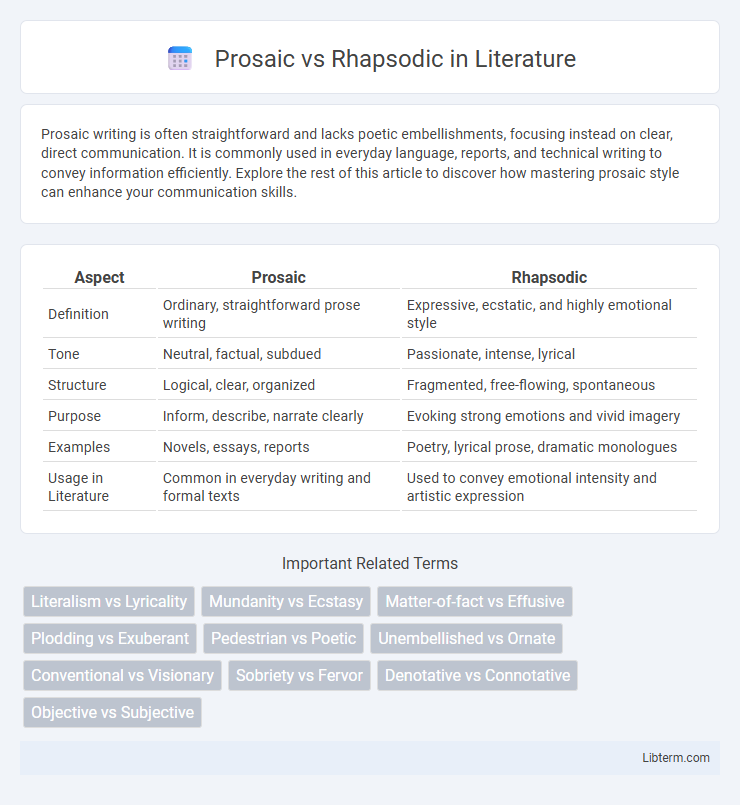Prosaic writing is often straightforward and lacks poetic embellishments, focusing instead on clear, direct communication. It is commonly used in everyday language, reports, and technical writing to convey information efficiently. Explore the rest of this article to discover how mastering prosaic style can enhance your communication skills.
Table of Comparison
| Aspect | Prosaic | Rhapsodic |
|---|---|---|
| Definition | Ordinary, straightforward prose writing | Expressive, ecstatic, and highly emotional style |
| Tone | Neutral, factual, subdued | Passionate, intense, lyrical |
| Structure | Logical, clear, organized | Fragmented, free-flowing, spontaneous |
| Purpose | Inform, describe, narrate clearly | Evoking strong emotions and vivid imagery |
| Examples | Novels, essays, reports | Poetry, lyrical prose, dramatic monologues |
| Usage in Literature | Common in everyday writing and formal texts | Used to convey emotional intensity and artistic expression |
Understanding Prosaic and Rhapsodic: Definitions
Prosaic refers to language or expression that is straightforward, ordinary, and lacking in poetic beauty or emotional intensity, often associated with everyday speech or factual writing. Rhapsodic denotes a style that is intensely emotional, enthusiastic, or ecstatic, typically characterized by lyrical, poetic, and highly expressive language. Understanding these terms helps distinguish between plain, descriptive communication and vibrant, impassioned expression in literary and conversational contexts.
Historical Origins of Prosaic and Rhapsodic Styles
The historical origins of prosaic style trace back to ancient Roman and Greek orators who emphasized straightforward, clear communication in speeches and writings, establishing prose as the norm for practical discourse. Rhapsodic style, rooted in Ancient Greece, emerged from the tradition of rhapsodes--performers who recited epic poetry with emotional intensity and rhythmic flow, aiming to evoke passionate responses. These divergent origins reflect prosaic's alignment with rational clarity and rhapsodic's connection to lyrical expression and emotional appeal.
Key Characteristics of Prosaic Writing
Prosaic writing is characterized by straightforward, clear, and unembellished language that prioritizes clarity and practicality over artistic flair. It employs ordinary syntax and common vocabulary, making it accessible and easy to understand without relying on poetic devices or elaborate imagery. Key elements include a logical structure, factual tone, and a focus on conveying information effectively rather than evoking emotional or imaginative responses.
Hallmarks of the Rhapsodic Approach
The rhapsodic approach is hallmarked by its expressive intensity, emotional exuberance, and spontaneous flow of ideas that defy rigid structure. It thrives on vivid imagery, lyrical language, and a dynamic rhythm that evokes passion and creativity, contrasting sharply with the straightforward, factual nature of prosaic expression. Key features include an emphasis on imaginative exploration, sensory-rich descriptions, and an unpredictable narrative style that captivates and inspires.
Prosaic vs Rhapsodic: Structural Differences
Prosaic text is characterized by straightforward, clear sentence structures following conventional grammar and syntax, making it easy to read and understand. Rhapsodic writing features more fluid, often irregular structures, employing vivid imagery and emotional intensity that disrupt traditional syntax for expressive effect. These structural differences highlight how prosaic style prioritizes clarity and coherence, while rhapsodic style emphasizes emotional resonance and artistic immersion.
Emotional Impact: Practical vs Poetic Expression
Prosaic writing delivers emotional impact through clear, straightforward expression, making feelings accessible and relatable in everyday contexts. Rhapsodic language evokes intense emotions by using poetic devices such as metaphor, rhythm, and vivid imagery, amplifying the reader's emotional experience. This contrast highlights practical communication versus artistic, emotionally charged expression.
Uses and Contexts: Where Each Style Shines
Prosaic language excels in technical writing, academic papers, and business communication where clarity, precision, and straightforwardness are essential. Rhapsodic style thrives in poetry, literary fiction, and speeches that aim to evoke emotion, inspire, and create vivid imagery. Understanding the context helps writers choose prosaic prose for facts and arguments, while rhapsodic language amplifies artistic and persuasive impact.
Notable Authors: Prosaic and Rhapsodic Examples
Notable authors known for prosaic writing include George Orwell and Ernest Hemingway, who emphasize clarity, straightforward language, and realistic depictions in their works such as "1984" and "The Old Man and the Sea." In contrast, rhapsodic writers like Walt Whitman and Virginia Woolf employ lyrical, highly expressive styles marked by emotional intensity and rhythmic prose, evident in "Leaves of Grass" and "Mrs. Dalloway." These contrasting approaches highlight how prosaic literature prioritizes direct communication while rhapsodic literature focuses on evocative, poetic expression.
Blending Prosaic and Rhapsodic Techniques
Blending prosaic and rhapsodic techniques enhances literary works by integrating the straightforward clarity of prose with the emotional intensity and lyrical richness of rhapsody. This fusion allows writers to balance narrative coherence with vivid, expressive language, creating a dynamic reading experience that resonates intellectually and emotionally. Employing this combination can deepen thematic impact and engage diverse audiences by weaving factual detail with passionate, poetic elements.
Choosing the Right Style for Your Purpose
Choosing between prosaic and rhapsodic styles depends on your communication goals and audience expectations. Prosaic writing offers clarity and straightforwardness, making it ideal for informative or instructional content. Rhapsodic style, with its emotional intensity and vivid imagery, suits creative expressions and persuasive narratives that aim to inspire or evoke strong feelings.
Prosaic Infographic

 libterm.com
libterm.com